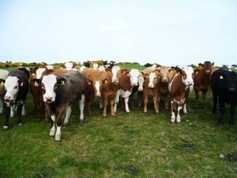Removing non performers
Culling can take place in two ways, either voluntary or involuntary. In most cases farmers cull cows out of necessity (involuntary). These may be un-productive cows that do not go back in calf, cows that become injured at times through the year or in some cases due to age.
However, in order to improve genetic gains, tighten the calving pattern or to improve herd fertility issues quickly, voluntary culling may also be required.
Farmers should be aware that voluntarily culling un-productive cows or cows with poor fertility should not be done on a whim. Culling and replacing cows with heifers will always come with an upfront cost.
The cull cows’ value will rarely cover the cost of the replacement heifer so it is essential to budget carefully before implementing a culling strategy. Culling should be planned and herd data such as the suckler cow report or the farmers own data should be used to identify cows suitable for voluntary culling.
Improve the efficiency of the herd
Margins are small in any suckler to weanling or suckler to beef system. It is essential that only efficient and productive cows are bred on the farm.
The average suckler cow in Ireland produces 0.82 calves per cow per year. Applying this figure to a 40 cow herd will mean that slightly over 33 calves are available to sell each year from the herd.
Farmers always talk about the cost of keeping the cow, but if there were an additional seven calves to sell each year, the output of the farm would be significantly higher and costs on a per cow basis would reduce significantly.
Ideally, a herd should produce 0.95 calves per cow per year or better. The first step in achieving this should be to take an in-depth look at the herd on a per cow basis and remove the stragglers that are dragging down profits and increasing costs.
Targets
1) Calve every 365 days
2) Produce 0.95 calves per year
3) Keep a tight calving spread of 12 weeks
4) Calves should weigh approx. 300kg at weaning (8 months)
Unproductive cows
At this stage, cows that did not go in calf last year should be culled by now, or should be almost factory fit. In some cases, where farmers are under-stocked or have a large run of ground for the summers months will turn culls back out to grass and finish over the summer months to exploit cheap liveweight gain.
One thing that should be avoided at all costs is recycling of cows from spring to autumn herds. When a cow does not go back in calf easily, and management has not been a factor, then there may be an underlying fertility issue. Recycling these cows is not a saving and will be even more costly in the long run.
Poor quality calves
It is essential to keep accurate records. Farmers with HerdPlus that sell weanlings will be able to use their suckler cow report to identify calves that produce light calves at weaning. Other farmers keep their own records of calf quality, weight, and price so that they have accurate data when deciding on what cows need to be culled for poor production.
A functional and milky cow, which calves in February, and managed well at grass, should have a calf weighing approximately 300kg at weaning in October. The output should be measured on both weight for age and calf quality.
If by 6 months of age the calf is still well below weight targets, then this may be an indicator of low cow milk yield. Studies at Grange have showed cow milk yield to be a key driver of weight for age.
Mastitis, foot problems and age
It is much more common for mastitis to lead to the need of a suckler cow being culled than culling due to foot problems. Never the less, both can be issues on many farms.
Mastitis can hit any cow, but in general is a more common problem with autumn calving herds as cows are generally dried off in warm weather when there is a lot of fly activity. Where mastitis is an issue on the farm, the first port of call should be to look at management practices from drying off right up to calving.
Where cows have lost quarters due to mastitis, milk yield can be affected, likewise with cows that suffer from chronic mastitis. This can have a negative effect on calf weight gain and may be cause for culling.
Culling may also be necessary due to foot problems, infections or injury. In most cases this will lead to involuntary culling. Age may also be another reason for culling. However, in my view, farmers should plan this in advance. Allowing cows to get too old before culling is very counterproductive.
As a cow ages her milk yield and productivity declines and in most cases she will become less efficient. In addition, if the farmer wishes to fatten the cow for slaughter, weight gains will be lower and carcase grades may negatively be affected also. Likewise, if selling live, younger cows achieve higher cull cow values and are more easily sold than older cows.
Key points
Plan culling strategies carefullyIdentify the replacement strategyList cows firstly that must be culled due to health, age etcSet targets for the herd in termsIdentify cows that can be culled due to poor productivity 




SHARING OPTIONS: